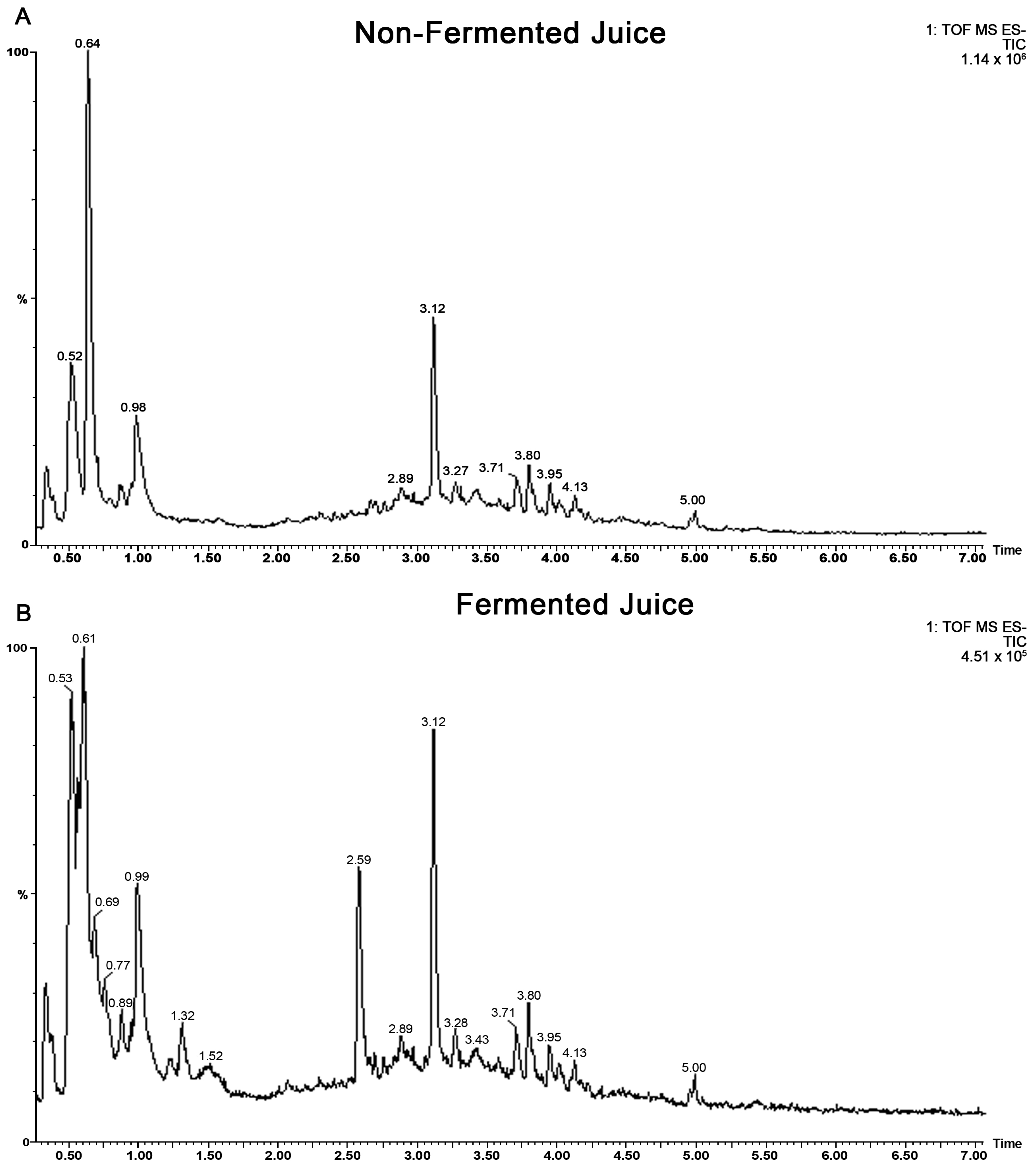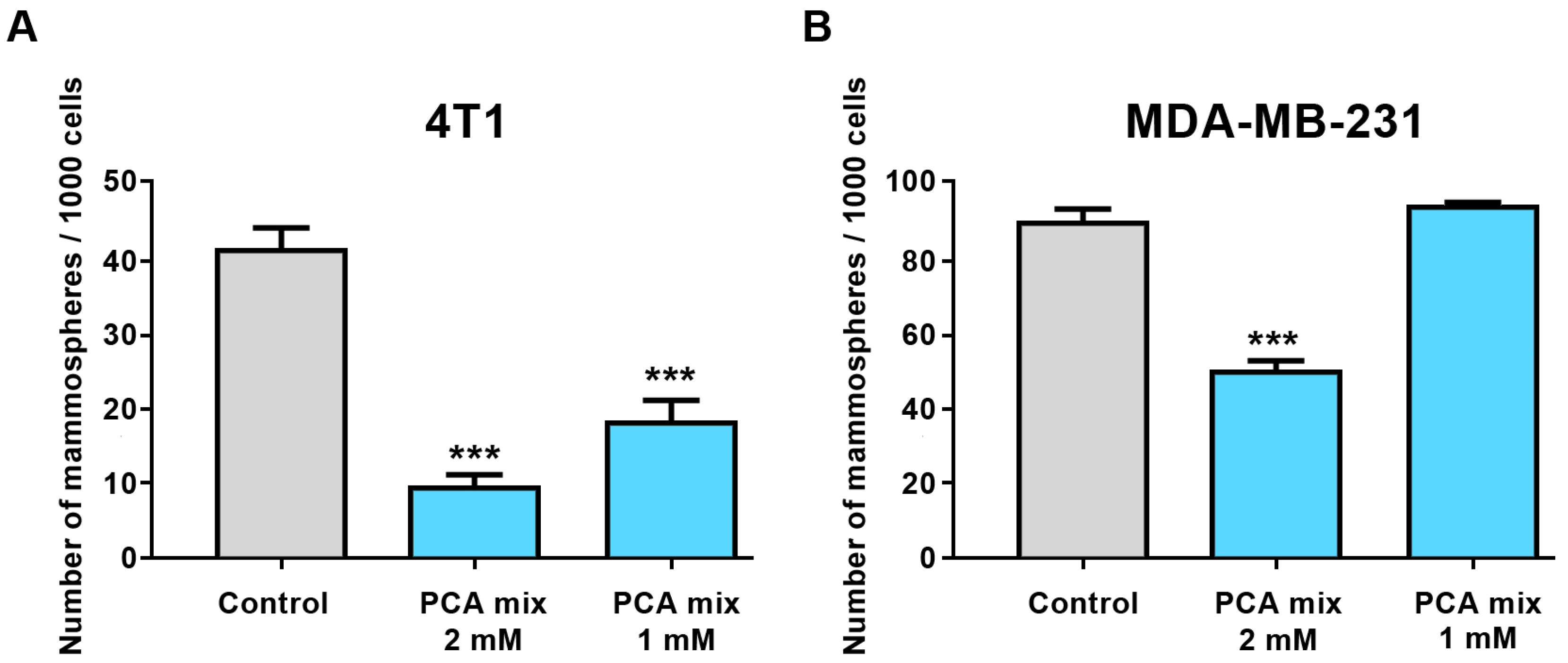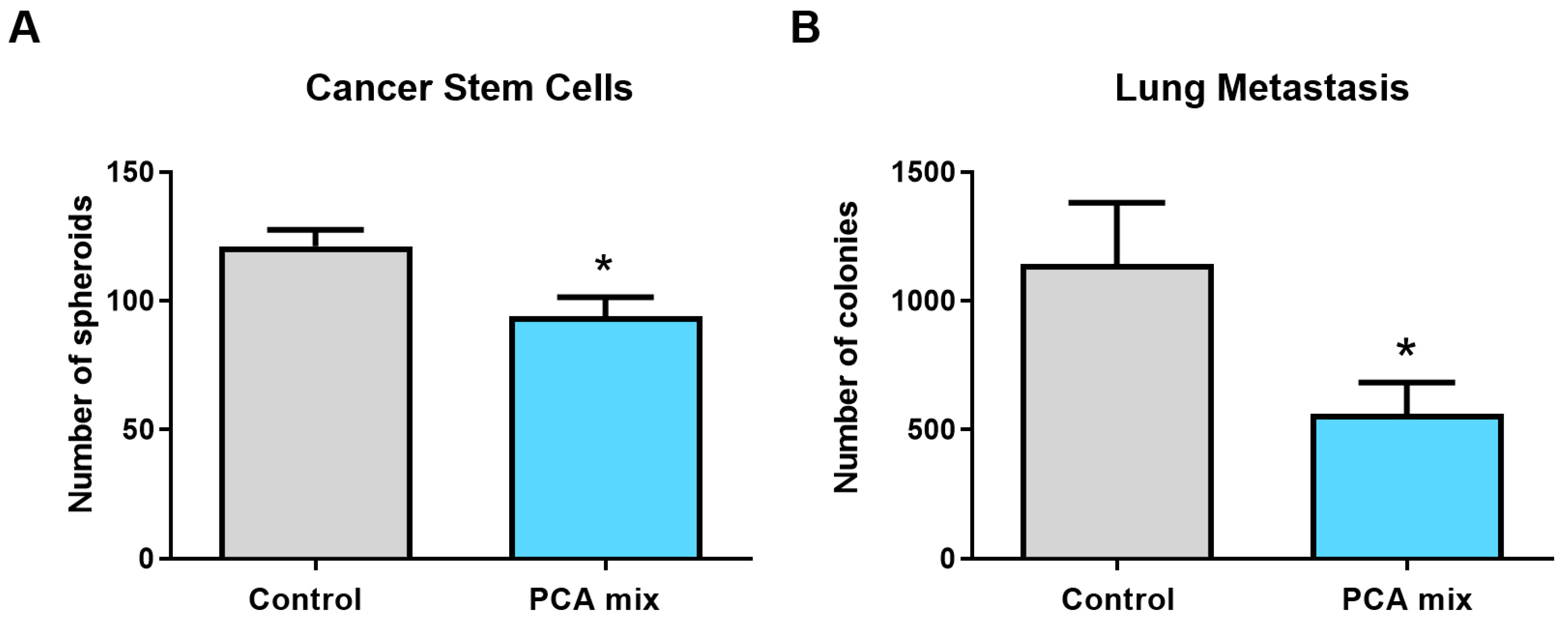Role of a Mixture of Polyphenol Compounds Released after Blueberry Fermentation in Chemoprevention of Mammary Carcinoma: In Vivo Involvement of miR-145
Abstract
:1. Introduction
2. Results
2.1. UPLC-QTOF Analysis of Fermented and Non-Fermented Blueberry Juice
2.2. Identification, Quantification, and Discriminant Analysis of Metabolites
2.3. Effect of the Polyphenolic Mixture on Mammospheres Formation in 4T1 and MDA-MB-231 Cell Cultures
2.4. Effect of the Polyphenolic Mixture on FOXO1 and N-ras Expressions in 4T1 and MDA-MB-231 Cell Lines
2.5. Effect of the Polyphenolic Mixture on miR-145 and miR-210-5p Expressions in Tumor Samples
2.6. Effect of the Polyphenolic Mixture on Spheroids Formation and Metastasis Ex Vivo
3. Discussion
4. Materials and Methods
4.1. Preparation of Blueberry Juices
4.2. Metabolite Selection
4.3. Sample Preparation
4.4. Ultra-Performance Liquid Chromatography-Quadrupole Time-of-Flight Mass Spectrometry (UPLC-MS-QTOF) Analysis
4.5. Cell Culture
4.6. In-Vivo Breast Cancer Model
4.7. Mammospheres Formation
4.8. Lung Metastasis
4.9. MicroRNAs Expression
4.10. Western Blot Analysis
4.11. Statistical Analysis
Author Contributions
Funding
Institutional Review Board Statement
Informed Consent Statement
Data Availability Statement
Acknowledgments
Conflicts of Interest
References
- Vuong, T.; Martin, L.; Matar, C. Antioxidant Activity of Fermented Berry Juices and Their Effects on Nitric Oxide and Tumor Necrosis Factor-Alpha Production in Macrophages 264.7 Gamma No(–) Cell Line. J. Food Biochem. 2006, 30, 249–268. [Google Scholar] [CrossRef]
- Shahbazi, R.; Sharifzad, F.; Bagheri, R.; Alsadi, N.; Yasavoli-Sharahi, H.; Matar, C. Anti-Inflammatory and Immunomodulatory Properties of Fermented Plant Foods. Nutrients 2021, 13, 1516. [Google Scholar] [CrossRef] [PubMed]
- Robichaud, S.; Shahbazi, R.; Matar, C. Role of Probiotics in Prevention of COVID-19 through Modulation of Gut–Lung Axis. In COVID-19 and Nutraceuticals: A Guidebook; Prasad, C., Öztürk, G., Eds.; Bohr Publishers: Tamil Nadu, India; New Century Health Publishers: Denton, TX, USA, 2021; pp. 33–62. [Google Scholar]
- Shahbazi, R.; Yasavoli-Sharahi, H.; Alsadi, N.; Ismail, N.; Matar, C. Probiotics in Treatment of Viral Respiratory Infections and Neuroinflammatory Disorders. Molecules 2020, 25, 4891. [Google Scholar] [CrossRef] [PubMed]
- Li, Q.; Li, N.; Cai, W.; Xiao, M.; Liu, B.; Zeng, F. Fermented Natural Product Targeting Gut Microbiota Regulate Immunity and Anti-Inflammatory Activity: A Possible Way to Prevent COVID-19 in Daily Diet. J. Funct. Foods 2022, 97, 105229. [Google Scholar] [CrossRef] [PubMed]
- Vuong, T.; Mallet, J.-F.; Ouzounova, M.; Rahbar, S.; Hernandez-Vargas, H.; Herceg, Z.; Matar, C. Role of a Polyphenol-Enriched Preparation on Chemoprevention of Mammary Carcinoma through Cancer Stem Cells and Inflammatory Pathways Modulation. J. Transl. Med. 2016, 14, 13. [Google Scholar] [CrossRef]
- Bornsek, S.M.; Ziberna, L.; Polak, T.; Vanzo, A.; Ulrih, N.P.; Abram, V.; Tramer, F.; Passamonti, S. Bilberry and Blueberry Anthocyanins Act as Powerful Intracellular Antioxidants in Mammalian Cells. Food Chem. 2012, 134, 1878–1884. [Google Scholar] [CrossRef]
- Martin, L.J.; Matar, C. Increase of Antioxidant Capacity of the Lowbush Blueberry (Vaccinium Angustifolium) during Fermentation by a Novel Bacterium from the Fruit Microflora. J. Sci. Food Agric. 2005, 85, 1477–1484. [Google Scholar] [CrossRef]
- Vuong, T.; Matar, C.; Ramassamy, C.; Haddad, P.S. Biotransformed Blueberry Juice Protects Neurons from Hydrogen Peroxide-Induced Oxidative Stress and Mitogen-Activated Protein Kinase Pathway Alterations. Br. J. Nutr. 2010, 104, 656–663. [Google Scholar] [CrossRef] [PubMed]
- Vuong, T.; Benhaddou-Andaloussi, A.; Brault, A.; Harbilas, D.; Martineau, L.C.; Vallerand, D.; Ramassamy, C.; Matar, C.; Haddad, P.S. Antiobesity and Antidiabetic Effects of Biotransformed Blueberry Juice in KKA(y) Mice. Int. J. Obes. 2009, 33, 1166–1173. [Google Scholar] [CrossRef]
- Vuong, T.; Martineau, L.C.; Ramassamy, C.; Matar, C.; Haddad, P.S. Fermented Canadian Lowbush Blueberry Juice Stimulates Glucose Uptake and AMP-Activated Protein Kinase in Insulin-Sensitive Cultured Muscle Cells and Adipocytes. Can. J. Physiol. Pharmacol. 2007, 85, 956–965. [Google Scholar] [CrossRef]
- Mallet, J.F.; Shahbazi, R.; Alsadi, N.; Matar, C. Polyphenol-Enriched Blueberry Preparation Controls Breast Cancer Stem Cells by Targeting FOXO1 and MiR-145. Molecules 2021, 26, 4330. [Google Scholar] [CrossRef] [PubMed]
- Alsadi, N.; Mallet, J.-F.; Matar, C. MiRNA-200b Signature in the Prevention of Skin Cancer Stem Cells by Polyphenol-Enriched Blueberry Preparation. J. Cancer Prev. 2021, 26, 162–173. [Google Scholar] [CrossRef] [PubMed]
- Hernandez-Vargas, H.; Ouzounova, M.; Le Calvez-Kelm, F.; Lambert, M.-P.; McKay-Chopin, S.; Tavtigian, S.V.; Puisieux, A.; Matar, C.; Herceg, Z. Methylome Analysis Reveals Jak-STAT Pathway Deregulation in Putative Breast Cancer Stem Cells. Epigenetics 2011, 6, 428–439. [Google Scholar] [CrossRef] [PubMed]
- Khan, A.Q.; Ahmed, E.I.; Elareer, N.R.; Junejo, K.; Steinhoff, M.; Uddin, S. Role of MiRNA-Regulated Cancer Stem Cells in the Pathogenesis of Human Malignancies. Cells 2019, 8, 840. [Google Scholar] [CrossRef]
- Choi, S.R.; Lee, M.Y.; Kim, S.A.; Oh, J.; Hyun, D.W.; Lee, S.; Lee, B.H.; Cho, J.Y.; Lee, C.H. Non-Targeted Metabolomics as a Screening Tool for Estimating Bioactive Metabolites in the Extracts of 50 Indigenous Korean Plants. Metabolites 2021, 11, 585. [Google Scholar] [CrossRef] [PubMed]
- Zhang, J.; Yu, Q.; Cheng, H.; Ge, Y.; Liu, H.; Ye, X.; Chen, Y. Metabolomic Approach for the Authentication of Berry Fruit Juice by Liquid Chromatography Quadrupole Time-of-Flight Mass Spectrometry Coupled to Chemometrics. J. Agric. Food Chem. 2018, 66, 8199–8208. [Google Scholar] [CrossRef]
- Yu, F.; Jin, L.; Yang, G.; Ji, L.; Wang, F.; Lu, Z. Post-Transcriptional Repression of FOXO1 by QKI Results in Low Levels of FOXO1 Expression in Breast Cancer Cells. Oncol. Rep. 2014, 31, 1459–1465. [Google Scholar] [CrossRef] [PubMed]
- Yahfoufi, N.; Alsadi, N.; Jambi, M.; Matar, C. The Immunomodulatory and Anti-Inflammatory Role of Polyphenols. Nutrients 2018, 10, 1618. [Google Scholar] [CrossRef]
- Mazurakova, A.; Koklesova, L.; Samec, M.; Kudela, E.; Kajo, K.; Skuciova, V.; Csizmár, S.H.; Mestanova, V.; Pec, M.; Adamkov, M. Anti-breast cancer effects of phytochemicals: Primary, secondary, and tertiary care. EPMA J. 2022, 13, 315–334. [Google Scholar] [CrossRef]
- Manach, C.; Williamson, G.; Morand, C.; Scalbert, A.; Rémésy, C. Bioavailability and Bioefficacy of Polyphenols in Humans. I. Review of 97 Bioavailability Studies. Am. J. Clin. Nutr. 2005, 81, 230S–242S. [Google Scholar] [CrossRef] [PubMed] [Green Version]
- Porras, D.; Nistal, E.; Martinez-Florez, S.; Pisonero-Vaquero, S.; Olcoz, J.L.; Jover, R.; Gonzalez-Gallego, J.; Gar-cia-Mediavilla, M.V.; Sanchez-Campos, S. Protective Effect of Quercetin on High-Fat Diet-Induced Non-Alcoholic Fatty Liver Disease in Mice Is Mediated by Modulating Intestinal Microbiota Imbalance and Related Gut-Liver Axis Activation. Free Radic. Biol. Med. 2017, 102, 188–202. [Google Scholar] [CrossRef]
- Han, M.; Song, Y.; Zhang, X. Quercetin Suppresses the Migration and Invasion in Human Colon Cancer Caco-2 Cells Through Regulating Toll-like Receptor 4/Nuclear Factor-Kappa B Pathway. Pharmacogn. Mag 2016, 12, 237–244. [Google Scholar]
- Nwaeburu, C.C.; Abukiwan, A.; Zhao, Z.; Herr, I. Quercetin-Induced MiR-200b-3p Regulates the Mode of Self-Renewing Divisions in Pancreatic Cancer. Mol. Cancer 2017, 16, 23. [Google Scholar] [CrossRef] [PubMed]
- Liu, Y.; Gong, W.; Yang, Z.Y.; Zhou, X.S.; Gong, C.; Zhang, T.R.; Wei, X.; Ma, D.; Ye, F.; Gao, Q.L. Quercetin Induces Protective Autophagy and Apoptosis through ER Stress via the P-STAT3/Bcl-2 Axis in Ovarian Cancer. Apoptosis Int. J. Program. Cell Death 2017, 22, 544–557. [Google Scholar] [CrossRef] [PubMed]
- Del Rio, D.; Costa, L.G.; Lean, M.E.; Crozier, A. Polyphenols and Health: What Compounds Are Involved? Nutr. Metab. Cardiovasc. Dis. 2010, 20, 1–6. [Google Scholar] [CrossRef] [PubMed]
- Serra, A.; Macia, A.; Romero, M.P.; Reguant, J.; Ortega, N.; Motilva, M.J. Metabolic pathways of the colonic metabolism of flavonoids (flavonols, flavones and flavanones) and phenolic acids. Food Chem. 2012, 130, 383–393. [Google Scholar] [CrossRef]
- Wang, D.; Xia, M.; Yan, X.; Li, D.; Wang, L.; Xu, Y.; Jin, T.; Ling, W. Gut Microbiota Metabolism of Anthocyanin Promotes Reverse Cholesterol Transport in Mice via Repressing MiRNA-10b. Circ. Res. 2012, 111, 967–981. [Google Scholar] [CrossRef] [PubMed]
- Yin, M.-C.; Lin, C.-C.; Wu, H.-C.; Tsao, S.-M.; Hsu, C.-K. Apoptotic Effects of Protocatechuic Acid in Human Breast, Lung, Liver, Cervix, and Prostate Cancer Cells: Potential Mechanisms of Action. J. Agric. Food Chem. 2009, 57, 6468–6473. [Google Scholar] [CrossRef]
- Nachar, A.; Eid, H.M.; Vinqvist-Tymchuk, M.; Vuong, T.; Kalt, W.; Matar, C.; Haddad, P.S. Phenolic Compounds Isolated from Fermented Blueberry Juice Decrease Hepatocellular Glucose Output and Enhance Muscle Glucose Uptake in Cultured Murine and Human Cells. BMC Complement. Altern. Med. 2017, 17, 138. [Google Scholar] [CrossRef] [PubMed]
- Lin, W.; Wang, W.; Yang, H.; Wang, D.; Ling, W. Influence of Intestinal Microbiota on the Catabolism of Flavonoids in Mice. J. Food Sci. 2016, 81, H3026–H3034. [Google Scholar] [CrossRef]
- Podberezin, M.; Wen, J.; Chang, C.C. Cancer Stem Cells: A Review of Potential Clinical Applications. Arch. Pathol. Lab. Med. 2013, 137, 1111–1116. [Google Scholar] [CrossRef] [PubMed] [Green Version]
- Wicha, M.S. Identification of Murine Mammary Stem Cells: Implications for Studies of Mammary Development and Carcinogenesis. Breast Cancer Res. 2006, 8, 109. [Google Scholar] [CrossRef]
- Dontu, G.; Al-Hajj, M.; Abdallah, W.M.; Clarke, M.F.; Wicha, M.S. Stem Cells in Normal Breast Development and Breast Cancer. Cell Prolif. 2003, 36, 59–72. [Google Scholar] [CrossRef] [PubMed]
- Manuel Iglesias, J.; Beloqui, I.; Garcia-Garcia, F.; Leis, O.; Vazquez-Martin, A.; Eguiara, A.; Cufi, S.; Pavon, A.; Menendez, J.A.; Dopazo, J. Mammosphere Formation in Breast Carcinoma Cell Lines Depends upon Expression of E-Cadherin. PLoS ONE 2013, 8, e77281. [Google Scholar] [CrossRef] [PubMed]
- Liu, Z.; Ren, Y.; Meng, L.; Li, L.; Beatson, R.; Deng, J.; Zhang, T.; Liu, J.; Han, X. Epigenetic Signaling of Cancer Stem Cells During Inflammation. Front. Cell Dev. Biol. 2021, 9, 772211. [Google Scholar] [CrossRef] [PubMed]
- Taylor, W.F.; Jabbarzadeh, E. The Use of Natural Products to Target Cancer Stem Cells. Am. J. Cancer Res. 2017, 7, 1588–1605. [Google Scholar] [PubMed]
- Zou, C.; Xu, Q.; Mao, F.; Li, D.; Bian, C.; Liu, L.-Z.; Jiang, Y.; Chen, X.; Qi, Y.; Zhang, X.; et al. MiR-145 Inhibits Tumor Angiogenesis and Growth by N-RAS and VEGF. Cell Cycle Georget. Tex 2012, 11, 2137–2145. [Google Scholar] [CrossRef] [PubMed]
- Zeinali, T.; Mansoori, B.; Mohammadi, A.; Baradaran, B. Regulatory Mechanisms of MiR-145 Expression and the Importance of Its Function in Cancer Metastasis. Biomed. Pharmacother. 2019, 109, 195–207. [Google Scholar] [CrossRef] [PubMed]
- Gao, P.; Xing, A.-Y.; Zhou, G.-Y.; Zhang, T.-G.; Zhang, J.-P.; Gao, C.; Li, H.; Shi, D.-B. The Molecular Mechanism of MicroRNA-145 to Suppress Invasion-Metastasis Cascade in Gastric Cancer. Oncogene 2013, 32, 491–501. [Google Scholar] [CrossRef]
- Hazan, R.B.; Phillips, G.R.; Qiao, R.F.; Norton, L.; Aaronson, S.A. Exogenous Expression of N-Cadherin in Breast Cancer Cells Induces Cell Migration, Invasion, and Metastasis. J. Cell Biol. 2000, 148, 779–790. [Google Scholar] [CrossRef] [PubMed]
- Zhao, H.; Kang, X.; Xia, X.; Wo, L.; Gu, X.; Hu, Y.; Xie, X.; Chang, H.; Lou, L.; Shen, X. MiR-145 Suppresses Breast Cancer Cell Migration by Targeting FSCN-1 and Inhibiting Epithelial-Mesenchymal Transition. Am. J. Transl. Res. 2016, 8, 3106–3114. [Google Scholar]
- Younis, L.K.; El Sakka, H.; Haque, I. The Prognostic Value of E-Cadherin Expression in Breast Cancer. Int. J. Health Sci. 2007, 1, 43–51. [Google Scholar]
- Jiang, S.-B.; He, X.-J.; Xia, Y.-J.; Hu, W.-J.; Luo, J.-G.; Zhang, J.; Tao, H.-Q. MicroRNA-145–5p Inhibits Gastric Cancer Invasiveness through Targeting N-Cadherin and ZEB2 to Suppress Epithelial–Mesenchymal Transition. OncoTargets Ther. 2016, 9, 2305. [Google Scholar]
- Pulaski, B.A.; Ostrand-Rosenberg, S. Mouse 4T1 Breast Tumor Model. Curr. Protoc. Immunol. 2000, 39, 20–22. [Google Scholar] [CrossRef] [PubMed]
- Prasad, S.B.; Yadav, S.S.; Das, M.; Govardhan, H.B.; Pandey, L.K.; Singh, S.; Pradhan, S.; Narayan, G. Down Regulation of FOXO1 Promotes Cell Proliferation in Cervical Cancer. J. Cancer 2014, 5, 655–662. [Google Scholar] [CrossRef] [PubMed]
- Dong, T.; Zhang, Y.; Chen, Y.; Liu, P.; An, T.; Zhang, J.; Yang, H.; Zhu, W.; Yang, X. FOXO1 Inhibits the Invasion and Metastasis of Hepatocellular Carcinoma by Reversing ZEB2-Induced Epithelial-Mesenchymal Transition. Oncotarget 2016, 8, 1703–1713. [Google Scholar] [CrossRef]
- Li, Y.; Liu, X.; Lin, X.; Zhao, M.; Xiao, Y.; Liu, C.; Liang, Z.; Lin, Z.; Yi, R.; Tang, Z. Chemical Compound Cino-Bufotalin Potently Induces FOXO1-Stimulated Cisplatin Sensitivity by Antagonizing Its Binding Partner MYH9. Signal Transduct. Target. Ther. 2019, 4, 48. [Google Scholar] [CrossRef] [PubMed]
- Smit, L.; Berns, K.; Spence, K.; Ryder, W.D.; Zeps, N.; Madiredjo, M.; Beijersbergen, R.; Bernards, R.; Clarke, R.B. An Integrated Genomic Approach Identifies That the PI3K/AKT/FOXO Pathway Is Involved in Breast Cancer Tumor Initiation. Oncotarget 2015, 7, 2596–2610. [Google Scholar] [CrossRef]
- Malaney, S.; Daly, R.J. The Ras Signaling Pathway in Mammary Tumorigenesis and Metastasis. J. Mammary Gland Biol. Neoplasia 2001, 6, 101–113. [Google Scholar] [CrossRef]
- Banys-Paluchowski, M.; Milde-Langosch, K.; Fehm, T.; Witzel, I.; Oliveira-Ferrer, L.; Schmalfeldt, B.; Müller, V. Clinical Relevance of H-RAS, K-RAS, and N-RAS MRNA Expression in Primary Breast Cancer Patients. Breast Cancer Res. Treat. 2020, 179, 403–414. [Google Scholar] [CrossRef]
- Matchett, M.D.; MacKinnon, S.L.; Sweeney, M.I.; Gottschall-Pass, K.T.; Hurta, R.A. Inhibition of Matrix Metalloproteinase Activity in DU145 Human Prostate Cancer Cells by Flavonoids from Lowbush Blueberry (Vaccinium Angustifolium): Possible Roles for Protein Kinase C and Mitogen-Activated Protein-Kinase-Mediated Events. J. Nutr. Biochem. 2006, 17, 117–125. [Google Scholar] [CrossRef] [PubMed]






| Metabolite | Elemental Compound | Accurate Mass | Rt (min) | Ions Detected |
|---|---|---|---|---|
| Gallic acid | C7H6O5 | 170.0215 | 1.30 | 171.0293 (1+)/171.0295; 169.0137 (1−)/169.0131 |
| Delphinidin-3-O-galactoside | C21H21O12+ | 465.1033 | 2.30 | 465.1033 (1+)/465.1025; 463.08752 (1−)/463.0873 |
| Protocatechuic acid | C7H6O4 | 154.0266 | 2.31 | 155.0344 (1+)/155.0350; 153.0188 (1−)/153.0185 |
| Idaein | C21H21O11+ | 449.1084 | 2.50 | 449.1084 (+)/449.1081; 447.0930 (2−)/447.0928 |
| Catechol | C6H6O2 | 110.0368 | 2.58 | 111.0446 (1+)/112.9555, 130.9658; 109.0290 (1−)/109.0289 |
| Cyanidin-3-O-glucoside | C21H21O11+ | 449.1084 | 2.58 | 449.1084(+)/449.1070; 447.0912 (2−)/447.0911 |
| Salidroside | C14H20O7 | 300.1209 | 2.66 | 301.1287 (+)/323.1111 [M+Na]+1; 299.1131 (1−)/299.1138, 398.0308 |
| Pyrocatechol-O-β-D-glucopyranoside | C12H16O7 | 272.2600 | 2.69 | 273.0974 (1+)/295.0791 [M+Na]+, 326.0083; 271.0818 (1−)/271.0818 |
| Primulin | C23H25O12+ | 493.1346 | 2.83 | 493.1346(+)/493.1347, 331.0813 |
| Oxycoccicyanin | C22H23O11+ | 463.1240 | 2.84 | 464.1319 (+)/463.1225; 462.1162 (2−)/461.1078 |
| (+)-Catechin | C15H14O6 | 290.0790 | 2.88 | 291.0869 (1+)/291.0868,311.0532 * [M+Na]+1; 289.0712 (1−)/289.0717 |
| p-hydroxybenzoic acid | C7H6O3 | 138.0317 | 2.88 | 139.0395 (1+)/139.0395; 137.0239 (1−)/137.0237 |
| Oenin | C23H25O12+ | 493.1346 | 2.89 | 493.1346 (+)/493.1351; 491.1183(2−) |
| Procyanidin B2 | C30H26O12 | 578.1424 | 3.08 | 579.1503 (+)/579.1509; 577.1346 (2−)/577.1359 |
| Chlorogenic acid | C16H18O9 | 354.0951 | 3.12 | 355.1029(1+)/355.1008, 378.0843 [M+Na]+1; 353.0873 (1−)/353.0856, |
| (−)-Epicatechin | C15H14O6 | 290.0790 | 3.17 | 291.0869(1+)/291.0866; 289.0712 (1−)/298.0710 |
| Myricetin-3-O-galactoside | C21H20O13 | 480.3800 | 3.47 | 481.0982(1+)/481.0973,503.0801 *; 479.0826 (1−)/479.0826 |
| Myricetin-3-O-glucoside | C21H20O13 | 480.3800 | 3.51 | 481.0982 (1+)/481.0980; 479.0826 (1−)/479.0826 |
| Quercetin-3-D-galactoside | C21H20O12 | 464.0955 | 3.80 | 465.1033(1+)/465.1035,303.0509 *, 487.0849; 463.0877 (1−)/463.0871 |
| Quercetin-3-glucoside | C21H20O12 | 464.0955 | 3.83 | 465.1033 (1+)/465.1012, 303.0496 *; 463.0877 (1−)/463.0877 |
| Quercetin-3-O-rhamnoside | C21H20O11 | 448.1006 | 4.13 | 449.1084 (1+)/449.1086, 471.0895, 303.0502 *; 447.0927 (1)/447.0923 |
| Quercetin | C15H10O7 | 302.0427 | 4.91 | 303.0505 (1+)/303.0498; 301.0348 (1−)/301.0354 |
Disclaimer/Publisher’s Note: The statements, opinions and data contained in all publications are solely those of the individual author(s) and contributor(s) and not of MDPI and/or the editor(s). MDPI and/or the editor(s) disclaim responsibility for any injury to people or property resulting from any ideas, methods, instructions or products referred to in the content. |
© 2023 by the authors. Licensee MDPI, Basel, Switzerland. This article is an open access article distributed under the terms and conditions of the Creative Commons Attribution (CC BY) license (https://creativecommons.org/licenses/by/4.0/).
Share and Cite
Mallet, J.-F.; Shahbazi, R.; Alsadi, N.; Saleem, A.; Sobiesiak, A.; Arnason, J.T.; Matar, C. Role of a Mixture of Polyphenol Compounds Released after Blueberry Fermentation in Chemoprevention of Mammary Carcinoma: In Vivo Involvement of miR-145. Int. J. Mol. Sci. 2023, 24, 3677. https://doi.org/10.3390/ijms24043677
Mallet J-F, Shahbazi R, Alsadi N, Saleem A, Sobiesiak A, Arnason JT, Matar C. Role of a Mixture of Polyphenol Compounds Released after Blueberry Fermentation in Chemoprevention of Mammary Carcinoma: In Vivo Involvement of miR-145. International Journal of Molecular Sciences. 2023; 24(4):3677. https://doi.org/10.3390/ijms24043677
Chicago/Turabian StyleMallet, Jean-François, Roghayeh Shahbazi, Nawal Alsadi, Ammar Saleem, Agnes Sobiesiak, John Thor Arnason, and Chantal Matar. 2023. "Role of a Mixture of Polyphenol Compounds Released after Blueberry Fermentation in Chemoprevention of Mammary Carcinoma: In Vivo Involvement of miR-145" International Journal of Molecular Sciences 24, no. 4: 3677. https://doi.org/10.3390/ijms24043677
APA StyleMallet, J.-F., Shahbazi, R., Alsadi, N., Saleem, A., Sobiesiak, A., Arnason, J. T., & Matar, C. (2023). Role of a Mixture of Polyphenol Compounds Released after Blueberry Fermentation in Chemoprevention of Mammary Carcinoma: In Vivo Involvement of miR-145. International Journal of Molecular Sciences, 24(4), 3677. https://doi.org/10.3390/ijms24043677






